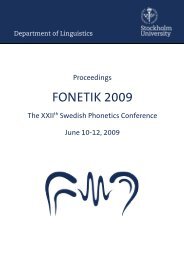Pronunciation variation modelling using decision tree induction from ...
Pronunciation variation modelling using decision tree induction from ...
Pronunciation variation modelling using decision tree induction from ...
You also want an ePaper? Increase the reach of your titles
YUMPU automatically turns print PDFs into web optimized ePapers that Google loves.
Proceedings, FONETIK 2004, Dept. of Linguistics, Stockholm University<br />
Future Work<br />
This paper presents work in progress. As the<br />
result of the exploration of resources and methods<br />
for annotation, one database has been fully<br />
annotated. For the final pronunciation <strong>variation</strong><br />
model, more speech data reflecting different<br />
speaking styles will be included. Databases<br />
available and partially annotated include human-computer<br />
dialogues, human-human dialogues,<br />
monologues and read aloud texts. With<br />
more varied speech data, a discourse annotation<br />
level with speaking style classifications will be<br />
included. Speaker age group will be included at<br />
the utterance level (when available) as well as<br />
the utterance mean relative speech rate.<br />
Much of the information provided with<br />
automatic methods depends on the presence of<br />
manually determined word boundaries. Such<br />
boundaries are not available for most databases.<br />
However, orthographic transcriptions are available.<br />
This means that an automatic alignment<br />
system (e.g. Sjölander, 2003) can be used and<br />
the output manually corrected. Information<br />
about prosodic boundaries and focal stress is<br />
available only for some of the speech databases.<br />
Supplying this information for all speech<br />
data will require some manual work, although<br />
the work can probably be facilitated through<br />
some degree of automation.<br />
Initial evaluations of the detailed transcriptions<br />
suggest that the error rate of the detailed<br />
transcription algorithm can be reduced by restricting<br />
the list of possible realisations for<br />
some segments to only the most common ones.<br />
The detailed transcription algorithm will be optimised<br />
and the output manually corrected.<br />
Also, more machine learning paradigms will be<br />
evaluated, starting with other rule <strong>induction</strong><br />
methods.<br />
Qualitative evaluations of the <strong>decision</strong> <strong>tree</strong><br />
classifications will have to be conducted and<br />
good evaluation measures developed. Different<br />
types of errors should be weighted for their<br />
gravity, <strong>using</strong> some (context dependent) phonetic<br />
distance measure. Some <strong>decision</strong> <strong>tree</strong> inducers<br />
allow different severity weights for different<br />
classification errors. This kind of error<br />
measure could thus also be used for model <strong>induction</strong>.<br />
Finally, it would be interesting to evaluate<br />
the model <strong>using</strong> synthetic speech. In a synthesis<br />
implementation, the parameters will have to be<br />
either supplied by the user or estimated <strong>from</strong><br />
the input. Redundancy and co-<strong>variation</strong> between<br />
parameters will have to be investigated<br />
in order to make the best use of the information<br />
that can be made available in a synthesis context.<br />
Notes<br />
1. www.cse.unsw.edu.au/~quinlan/<br />
2. ilk.kub.nl/software.html<br />
3. www.cs.waikato.ac.nz/ml/weka/<br />
4. fuzzy.cs.uni-magdeburg.de/~borgelt/doc/<br />
d<strong>tree</strong>/d<strong>tree</strong>.html<br />
Acknowledgements<br />
Many thanks to Kåre Sjölander and Bea Megyesi<br />
for their help with the annotation and to<br />
Robert Bannert and Peter Czigler for making<br />
their VaKoS database available. The research<br />
reported in this paper was carried out at the<br />
Centre for Speech Technology (CTT) at KTH.<br />
References<br />
Allwood, J. (1999) The Swedish spoken language<br />
corpus at Göteborg University. Proc<br />
Fonetik 1999.<br />
Aycock, J. (1998) Compiling little languages in<br />
Python. Proc 7th International Python Conference.<br />
Bannert, R. and Czigler, P. E. (1999) Variations<br />
in consonant clusters in standard Swedish.<br />
Phonum 7, Umeå University.<br />
Brants, T. (2000) TnT – A statistical part-ofspeech<br />
tagger. Proc 6th ANLP.<br />
Bruce, G. (1986) Elliptical phonology. Papers<br />
<strong>from</strong> the Ninth Scandinavian Conference on<br />
Linguistics, 86–95.<br />
Gårding, E. (1974) Sandhiregler för svenska<br />
konsonanter. Svenskans beskrivning 8, 97–<br />
106.<br />
Jande, P-A (2003a) Evaluating rules for phonological<br />
reduction in Swedish. Proc Fonetik<br />
2003, 149–152.<br />
Jande, P-A (2003b) Phonological reduction in<br />
Swedish. Proc 15th ICPhS, 2557–2560.<br />
Megyesi, B. (2002) Data-driven syntactic<br />
analysis – Methods and applications for<br />
Swedish. Ph. D. Thesis. KTH, Stockholm.<br />
Sjölander, K. (2003) An HMM-based system<br />
for automatic segmentation and alignment<br />
of speech. Proc Fonetik 2003, 193–196.<br />
Quinlan, J. R. (1993) C4.5: Programs for machine<br />
learning. San Mateo: Morgan Kaufmann.

















